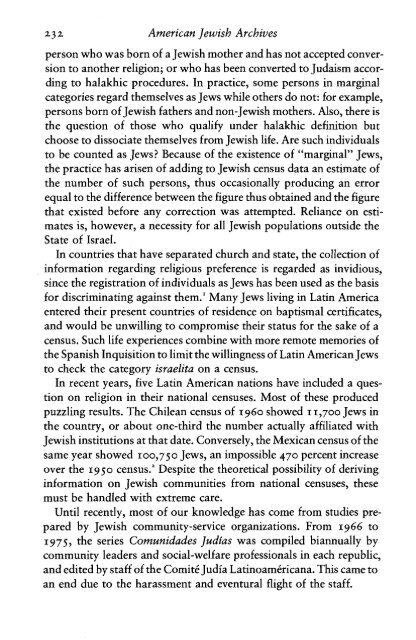Introduction - American Jewish Archives
Introduction - American Jewish Archives
Introduction - American Jewish Archives
You also want an ePaper? Increase the reach of your titles
YUMPU automatically turns print PDFs into web optimized ePapers that Google loves.
232 <strong>American</strong> <strong>Jewish</strong> <strong>Archives</strong><br />
person who was born of a <strong>Jewish</strong> mother and has not accepted conver-<br />
sion to another religion; or who has been converted to Judaism accor-<br />
ding to halakhic procedures. In practice, some persons in marginal<br />
categories regard themselves as Jews while others do not: for example,<br />
persons born of <strong>Jewish</strong> fathers and non-<strong>Jewish</strong> mothers. Also, there is<br />
the question of those who qualify under halakhic definition but<br />
choose to dissociate themselves from <strong>Jewish</strong> life. Are such individuals<br />
to be counted as Jews? Because of the existence of "marginal" Jews,<br />
the practice has arisen of adding to <strong>Jewish</strong> census data an estimate of<br />
the number of such persons, thus occasionally producing an error<br />
equal to the difference between the figure thus obtained and the figure<br />
that existed before any correction was attempted. Reliance on esti-<br />
mates is, however, a necessity for all <strong>Jewish</strong> populations outside the<br />
State of Israel.<br />
In countries that have separated church and state, the collection of<br />
information regarding religious preference is regarded as invidious,<br />
since the registration of individuals as Jews has been used as the basis<br />
for discriminating against them.' Many Jews living in Latin America<br />
entered their present countries of residence on baptismal certificates,<br />
and would be unwilling to compromise their status for the sake of a<br />
census. Such life experiences combine with more remote memories of<br />
the Spanish Inquisition to limit the willingness of Latin <strong>American</strong> Jews<br />
to check the category israelita on a census.<br />
In recent years, five Latin <strong>American</strong> nations have included a ques-<br />
tion on religion in their national censuses. Most of these produced<br />
puzzling results. The Chilean census of 1960 showed I 1,700 Jews in<br />
the country, or about one-third the number actually affiliated with<br />
<strong>Jewish</strong> institutions at that date. Conversely, the Mexican census of the<br />
same year showed 100,750 Jews, an impossible 470 percent increase<br />
over the 1950 census.' Despite the theoretical possibility of deriving<br />
information on <strong>Jewish</strong> communities from national censuses, these<br />
must be handled with extreme care.<br />
Until recently, most of our knowledge has come from studies pre-<br />
pared by <strong>Jewish</strong> community-service organizations. From 1966 to<br />
1975, the series Comunidades Judias was compiled biannually by<br />
community leaders and social-welfare professionals in each republic,<br />
and edited by staff of the ComitC Judia LatinoamCricana. This came to<br />
an end due to the harassment and eventural flight of the staff.

















